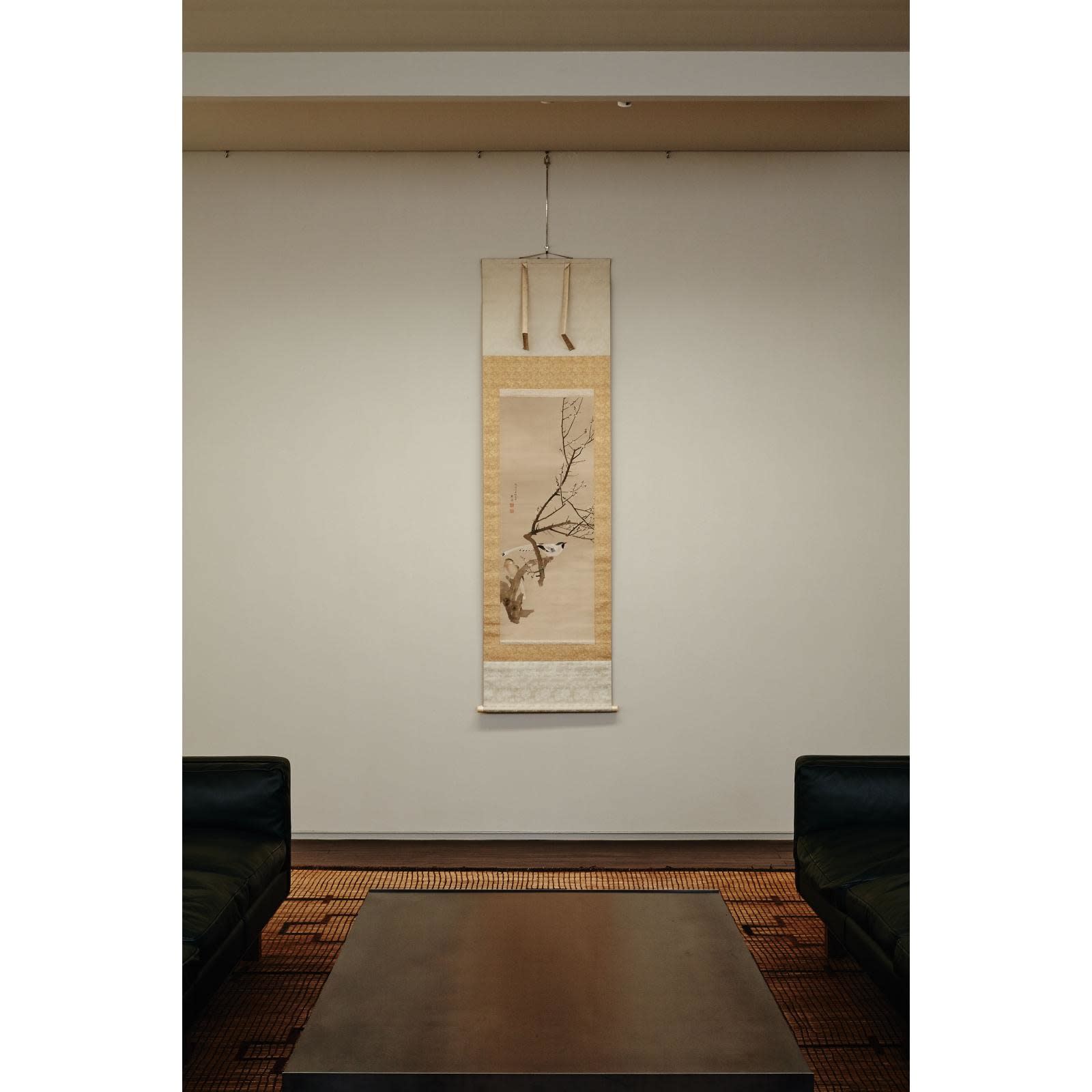Maruyama Ōkyo (1733–1795)
White Plum and Jutaichō
Color on silk, hanging scroll
Dated Tenmei 8 (1788)
With box authentication by Maruyama Oryu (1862), double boxed
Seals: Okyo no in; Chusen
105.4 x 41.1 cm
197 x 55.8 cm (overall)
Dated Tenmei 8 (1788)
With box authentication by Maruyama Oryu (1862), double boxed
Seals: Okyo no in; Chusen
105.4 x 41.1 cm
197 x 55.8 cm (overall)
Further images
Provenance
Collection of Ogawa Kenzaburo (Aibaikyo)Literature
Aibaikyo zohin tenkan zuroku. Osaka: Osaka Bijutsu Kurabu, 1937.Sasaki Johei and Sasaki Masako. MaruyamaOkyo kenkyu zuroku hen. Tokyo: Chuo-koron Bijutsu Shuppan, 1996.
Maruyamaukyogashu. Kyoto: Kyoto Shinbunsha, 1999.
The jutaicho, or magpie in English, inhabits China, but not Japan. Okyo, therefore, must have based, directly or indirectly, on a Chinese model. A pair of jutaicho, are also seen in Yosa Buson’s Two Birds on Willow and Peach Trees (Mary and Jackson Burke Foundation, New York), which is believed to be a copy of a hanging scroll with the sign and seals of the Chinese painter Shen Nanpin (b. 1682). Although its authenticity is in doubt and no other example of jutaicho by Shen and his Chinese followers is known, it is most possible that these Chinese artists brought the Japanese painters images of the bird.
From 1731 to 1733, Shen Nanpin stayed in Nagasaki, the only city open to foreigners, namely the Dutch and the Chinese, during the Edo period. His stay was very brief, but his realistic style influenced many Japanese artists, who are now grouped together under the name “Nanpin-ha” (Nanpin school). Several examples of jutaicho can be found among paintings of Nanpin-ha artists. In particular, a pair of jutaicho in Shokatsu Kan’s Small Birds on Plum Tree (Itabashi Art Museum, Tokyo) is very similar to Okyo’s, though the direction of the bird depicted in profile is reversed. It is not that Okyo imitated Shokatsu nor the other way around, but that both are possibly based on the same Chinese model.
In contrast to the birds, Okyo represented a plum tree in the traditional ink style. Its branches, rendered in differentiated tones, overlap each other, so as to create a three dimensional effect. One branch even overlaps the bird depicted in profile, reinforcing the depth of the representation of the space.
This painting is dated in the first month of Tenmei 8 (1788). On the last day of that month, a great fire broke out in Kyoto and destroyed a large part of the city, including Okyo’s house. Although he resumed painting soon and continued producing a great many masterpieces, the lucidity demonstrated in this painting seemed to be gone after the fire. Therefore, the present work is one of the last ones, which bears the lucidity found no more in Okyo’s later works.
Maruyama Okyo (painter; 1733−1795)
Also known as Sensai; Chusen; Issho; Kaun; Senrei; Mondo.
Tamba-born late Edo period painter and the progenitor of the Maruyama School. Learned the Kano School painting technique under Ishida Yutei. Remarkably integrated the Chinese Song and Yuan dynasty painting techniques and the Western perspective method into Yutei’s shasei (direct observation from life) technique, and formed his distinctive style. Excelled at animal and botanical shasei paintings.
From 1731 to 1733, Shen Nanpin stayed in Nagasaki, the only city open to foreigners, namely the Dutch and the Chinese, during the Edo period. His stay was very brief, but his realistic style influenced many Japanese artists, who are now grouped together under the name “Nanpin-ha” (Nanpin school). Several examples of jutaicho can be found among paintings of Nanpin-ha artists. In particular, a pair of jutaicho in Shokatsu Kan’s Small Birds on Plum Tree (Itabashi Art Museum, Tokyo) is very similar to Okyo’s, though the direction of the bird depicted in profile is reversed. It is not that Okyo imitated Shokatsu nor the other way around, but that both are possibly based on the same Chinese model.
In contrast to the birds, Okyo represented a plum tree in the traditional ink style. Its branches, rendered in differentiated tones, overlap each other, so as to create a three dimensional effect. One branch even overlaps the bird depicted in profile, reinforcing the depth of the representation of the space.
This painting is dated in the first month of Tenmei 8 (1788). On the last day of that month, a great fire broke out in Kyoto and destroyed a large part of the city, including Okyo’s house. Although he resumed painting soon and continued producing a great many masterpieces, the lucidity demonstrated in this painting seemed to be gone after the fire. Therefore, the present work is one of the last ones, which bears the lucidity found no more in Okyo’s later works.
Maruyama Okyo (painter; 1733−1795)
Also known as Sensai; Chusen; Issho; Kaun; Senrei; Mondo.
Tamba-born late Edo period painter and the progenitor of the Maruyama School. Learned the Kano School painting technique under Ishida Yutei. Remarkably integrated the Chinese Song and Yuan dynasty painting techniques and the Western perspective method into Yutei’s shasei (direct observation from life) technique, and formed his distinctive style. Excelled at animal and botanical shasei paintings.











